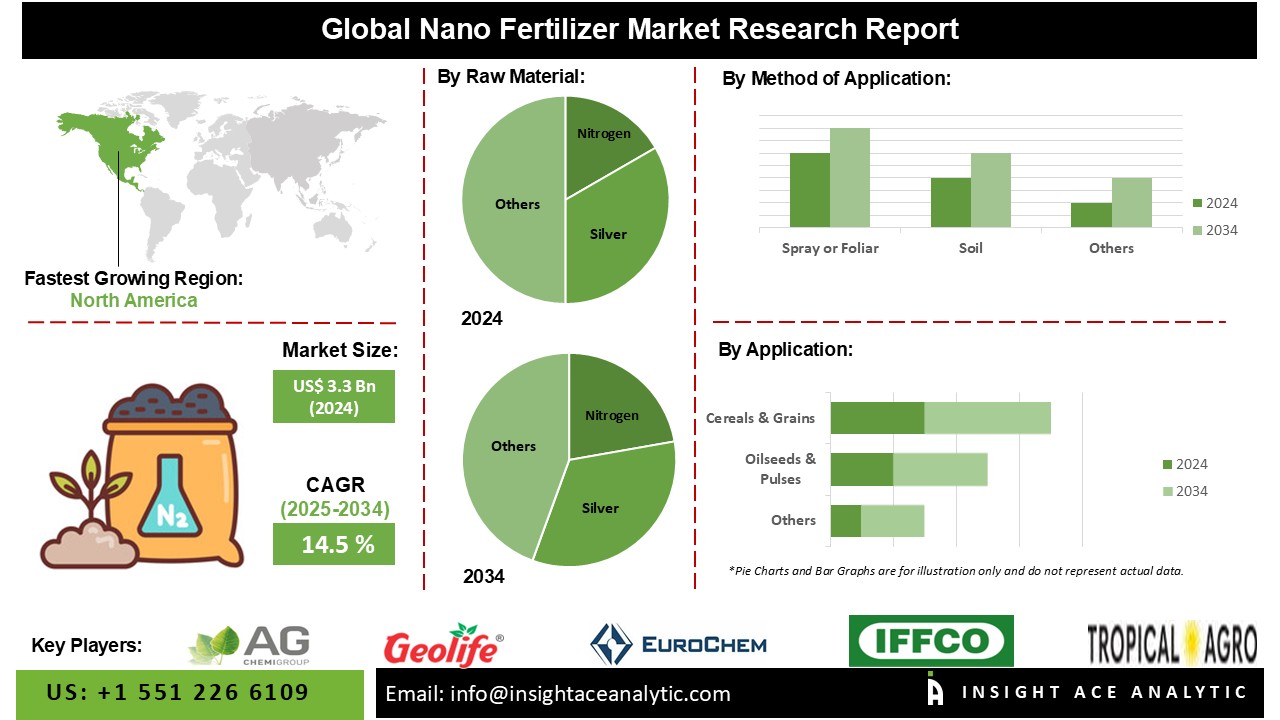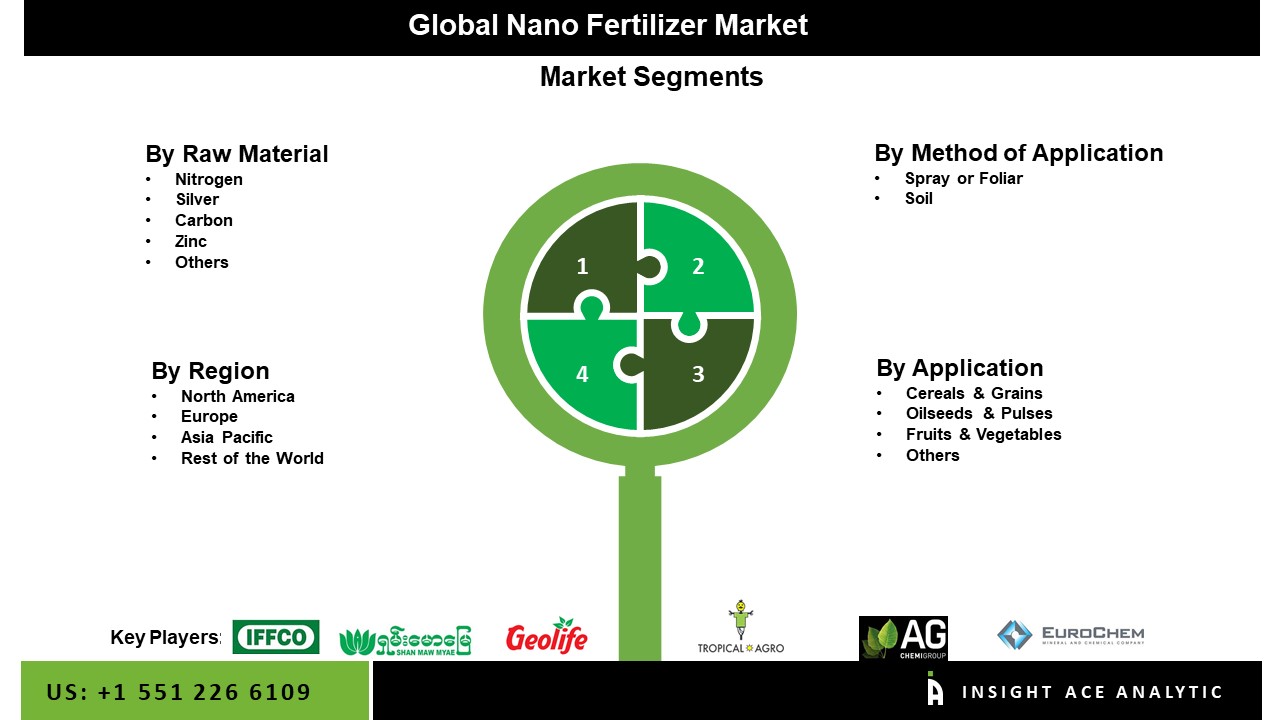Nano Fertilizer Market Size is valued at USD 3.3 billion in 2024 and is predicted to reach USD 12.6 billion by the year 2034 at an 14.5% CAGR during the forecast period for 2025-2034.
Key Industry Insights & Findings from the Report:

Nano fertilizers aid in enhancing an agricultural manufacturer's nutritional benefit. Due to their affordability and lower usage requirements, nano fertilizers are more advantageous than chemical fertilizers. Farmers may use nano fertilizers instead of chemical fertilizers due to reported incorrect usage of chemical fertilizers and their effects on the agroecosystem.
The urge to switch from chemical fertilizers to nano fertilizers is helping the market for nano fertilizers to grow, as projected in the upcoming years. The agricultural sector is among the most important industries that must run smoothly and properly. There is a growing demand for fertilizers as environmental toxicity rises. The innovative development of nanotechnology has paved the way for the large-scale synthesis of the nanoparticles used to create nano-fertilizers. Furthermore, the expansion of the global market for nano fertilizers over the next five years would be aided by the growing world population. In the upcoming five years, rising demand for crops with higher yields will further support the expansion of the worldwide nano fertilizers industry.
Additionally, ongoing research into novel approaches has resulted in the creation of novel nanomaterials, providing a potent tool for creating new technology products that are effectively supplied via soil application method and supporting the sub-growth segment as well as the expansion of the global market.
The nano fertilizer market is segmented on the raw materials, methods of applications and application. Based on raw materials, the market is segmented into nitrogen, silver, carbon, zinc and others. Based on the methods of applications, the nano fertilizer market is segmented into a spray or foliar and soil. Based on applications, the nano fertilizer market is segmented into cereals & grains, oilseeds & pulses, fruits & vegetables and others.
The market's leading segment is oilseeds & pulses. This is due to their stable molecular arrangement, low toxicity, and uniform dispersion, which makes them great fertilizer carriers. In addition, they are also used as light converters for supplementing the photosynthesis of plants. All these factors contribute to increased demand for carbon-based nanomaterials. Among the carbon-based nanomaterials, carbon tubes witnessed more traction in the agricultural sector. The carbon tubes embed the ability to nano transport cross plant cell walls, impact plant growth regulation, and act as a medium for biosensors. Thus, they can act as both plant growth boosters and slow-release fertilizers.
Carbon grabbed the highest revenue share, and it is anticipated that they will continue to hold that position during the anticipated time. This is due to their stable molecular arrangement, low toxicity, and uniform dispersion, which makes them great fertilizer carriers. In addition, they are also used as light converters for supplementing the photosynthesis of plants. All these factors contribute to increased demand for carbon-based nanomaterials. Among the carbon-based nanomaterials, carbon tubes witnessed more traction in the agricultural sector. The carbon tubes embed the ability to nano transport cross plant cell walls, impact plant growth regulation, and act as a medium for biosensors. Thus, they can act as both plant growth boosters and slow-release fertilizers.
The North American nano fertilizer market is expected to register the highest market share in revenue soon. This is because of emerging economies such as India, China, Vietnam, and Indonesia. The rise of India and China as the leading global producers of rice, wheat, cotton, and tea remains a major driver of growth in the region. Furthermore, Indonesia and Vietnam remain among the top 5 producers of coffee beans. This has led to an urgent need in the region to increase productivity. Furthermore, sustainability drives to meet the rising food demand of the region is, in turn, driving the demand for nano fertilizers in the region. In addition, Asia Pacific is projected to grow rapidly in the global nano fertilizer market. This is because of emerging economies such as India, China, Vietnam, and Indonesia. The rise of India and China as the leading global producers of rice, wheat, cotton, and tea remains a major driver of growth in the region. Furthermore, sustainability drives to meet the rising food demand of the region, in turn driving the demand for nano fertilizers.
| Report Attribute | Specifications |
| Market size value in 2024 | USD 3.3 Bn |
| Revenue forecast in 2034 | USD 12.6 Bn |
| Growth rate CAGR | CAGR of 14.5% from 2025 to 2034 |
| Quantitative units | Representation of revenue in US$ Million, Volume in Kilotons and CAGR from 2025 to 2034 |
| Historic Year | 2021 to 2024 |
| Forecast Year | 2025-2034 |
| Report coverage | The forecast of revenue, the position of the company, the competitive market structure, growth prospects, and trends |
| Segments covered | Raw Materials, Methods Of Applications And Application |
| Regional scope | North America; Europe; Asia Pacific; Latin America; Middle East & Africa |
| Country scope | U.S.; Canada; U.K.; Germany; China; India; Japan; Brazil; Mexico; The UK; France; Italy; Spain; South Korea; Southeast Asia |
| Competitive Landscape | Indian Farmers Fertilizer Cooperative Limited, Lazuriton Nano Biotechnology Co., Ltd., Fanavar Nano-Pazhoohesh Markazi Company, Tropical Agrosystem India (P) Ltd., EuroChem, Shan Maw Myae Trading Co., Ltd, Geolife Group, AG CHEMI Group, s.r.o., JU Agri Sciences Pvt. Ltd., and Nano Solutions |
| Customization scope | Free customization report with the procurement of the report, Modifications to the regional and segment scope. Particular Geographic competitive landscape. |
| Pricing and available payment methods | Explore pricing alternatives that are customized to your particular study requirements. |
Nano Fertilizer Market By Raw Material

Nano Fertilizer Market By Method of Application
Nano Fertilizer Market By Application
Nano Fertilizer Market By Region-
North America-
Europe-
Asia-Pacific-
Latin America-
Middle East & Africa-
Chapter 1. Methodology and Scope
1.1. Research Methodology
1.2. Research Scope & Assumptions
Chapter 2. Executive Summary
Chapter 3. Global Nano Fertilizer Market Snapshot
Chapter 4. Global Nano Fertilizer Market Variables, Trends & Scope
4.1. Market Segmentation & Scope
4.2. Drivers
4.3. Challenges
4.4. Trends
4.5. Investment and Funding Analysis
4.6. Industry Analysis – Porter’s Five Forces Analysis
4.7. Competitive Landscape & Market Share Analysis
4.8. Impact of Covid-19 Analysis
Chapter 5. Market Segmentation 1: by Raw Material Estimates & Trend Analysis
5.1. by Raw Material & Market Share, 2024 & 2034
5.2. Market Size (Value (US$ Mn) & Volume (Kilotons)) & Forecasts and Trend Analyses, 2021 to 2034 for the following by Raw Material:
5.2.1. Nitrogen
5.2.2. Silver
5.2.3. Carbon
5.2.4. Zinc
5.2.5. Others
Chapter 6. Market Segmentation 2: by Method of Application Estimates & Trend Analysis
6.1. by Method of Application & Market Share, 2024 & 2034
6.2. Market Size (Value (US$ Mn) & Volume (Kilotons)) & Forecasts and Trend Analyses, 2021 to 2034 for the following by Method of Application:
6.2.1. Spray or Foliar
6.2.2. Soil
Chapter 7. Market Segmentation 3: by Application Estimates & Trend Analysis
7.1. by Application & Market Share, 2024 & 2034
7.2. Market Size (Value (US$ Mn) & Volume (Kilotons)) & Forecasts and Trend Analyses, 2021 to 2034 for the following by Application:
7.2.1. Cereals & Grains
7.2.2. Oilseeds & Pulses
7.2.3. Fruits & Vegetables
7.2.4. Others
Chapter 8. Nano Fertilizer Market Segmentation 4: Regional Estimates & Trend Analysis
8.1. North America
8.1.1. North America Nano Fertilizer Market Revenue (US$ Million) & Volume (Kilotons) Estimates and Forecasts by Raw Material, 2021-2034
8.1.2. North America Nano Fertilizer Market Revenue (US$ Million) & Volume (Kilotons) Estimates and Forecasts by Method of Application, 2021-2034
8.1.3. North America Nano Fertilizer Market Revenue (US$ Million) & Volume (Kilotons) Estimates and Forecasts by Application, 2021-2034
8.1.4. North America Nano Fertilizer Market Revenue (US$ Million) & Volume (Kilotons) Estimates and Forecasts by country, 2021-2034
8.2. Europe
8.2.1. Europe Nano Fertilizer Market Revenue (US$ Million) & Volume (Kilotons) Estimates and Forecasts by Raw Material, 2021-2034
8.2.2. Europe Nano Fertilizer Market Revenue (US$ Million) & Volume (Kilotons) Estimates and Forecasts by Method of Application, 2021-2034
8.2.3. Europe Nano Fertilizer Market Revenue (US$ Million) & Volume (Kilotons) Estimates and Forecasts by Application, 2021-2034
8.2.4. Europe Nano Fertilizer Market Revenue (US$ Million) & Volume (Kilotons) Estimates and Forecasts by country, 2021-2034
8.3. Asia Pacific
8.3.1. Asia Pacific Nano Fertilizer Market Revenue (US$ Million) & Volume (Kilotons) Estimates and Forecasts by Raw Material, 2021-2034
8.3.2. Asia Pacific Nano Fertilizer Market Revenue (US$ Million) & Volume (Kilotons) Estimates and Forecasts by Method of Application, 2021-2034
8.3.3. Asia-Pacific Nano Fertilizer Market Revenue (US$ Million) & Volume (Kilotons) Estimates and Forecasts by Application, 2021-2034
8.3.4. Asia Pacific Nano Fertilizer Market Revenue (US$ Million) & Volume (Kilotons) Estimates and Forecasts by country, 2021-2034
8.4. Latin America
8.4.1. Latin America Nano Fertilizer Market Revenue (US$ Million) & Volume (Kilotons) Estimates and Forecasts by Raw Material, 2021-2034
8.4.2. Latin America Nano Fertilizer Market Revenue (US$ Million) & Volume (Kilotons) Estimates and Forecasts by Method of Application, 2021-2034
8.4.3. Latin America Nano Fertilizer Market Revenue (US$ Million) & Volume (Kilotons) Estimates and Forecasts by Application, 2021-2034
8.4.4. Latin America Nano Fertilizer Market Revenue (US$ Million) & Volume (Kilotons) Estimates and Forecasts by country, 2021-2034
8.5. Middle East & Africa
8.5.1. Middle East & Africa Nano Fertilizer Market Revenue (US$ Million) & Volume (Kilotons) Estimates and Forecasts by Raw Material, 2021-2034
8.5.2. Middle East & Africa Nano Fertilizer Market Revenue (US$ Million) & Volume (Kilotons) Estimates and Forecasts by Method of Application, 2021-2034
8.5.3. Middle East & Africa Nano Fertilizer Market Revenue (US$ Million) & Volume (Kilotons) Estimates and Forecasts by Application, 2021-2034
8.5.4. Middle East & Africa Nano Fertilizer Market Revenue (US$ Million) & Volume (Kilotons) Estimates and Forecasts by country, 2021-2034
Chapter 9. Competitive Landscape
9.1. Major Mergers and Acquisitions/Strategic Alliances
9.2. Company Profiles
9.2.1. Indian Farmers Fertilizer Cooperative Limited
9.2.2. Lazuriton Nano Biotechnology Co., Ltd.
9.2.3. Fanavar Nano-Pazhoohesh Markazi Company
9.2.4. Tropical Agrosystem India (P) Ltd.
9.2.5. EuroChem
9.2.6. Shan Maw Myae Trading Co., Ltd
9.2.7. Geolife Group
9.2.8. AG CHEMI Group, s.r.o.
9.2.9. JU Agri Sciences Pvt. Ltd.
9.2.10. Nano Solutions
9.2.11. Other Prominent Players